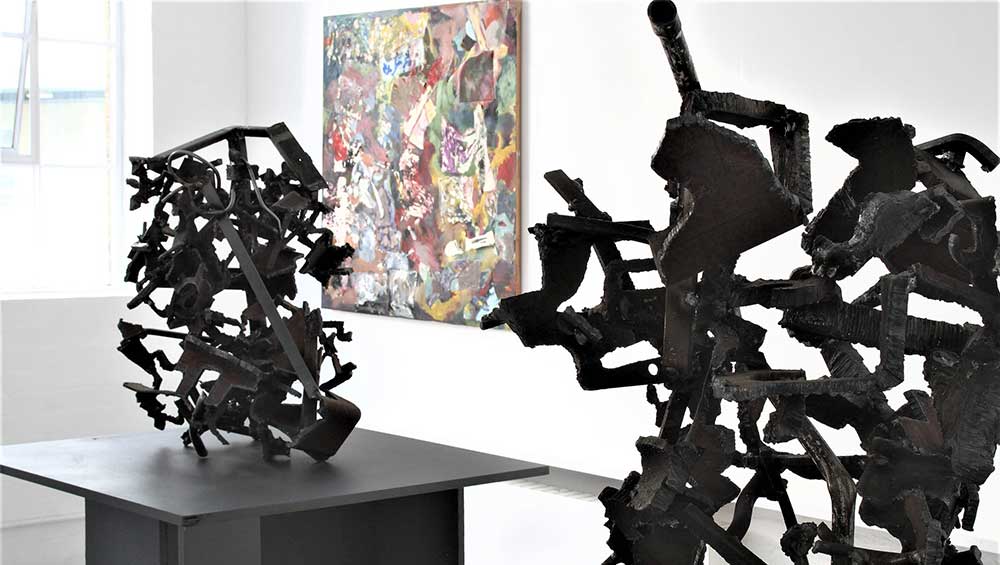
Robin Greenwood, abcrit.org, installation view. Image courtesy of the artist.
Abcrit.org, London
11 July – 31 August 2022
by SAM CORNISH
Abcrit.org is a new gallery in a yard off Bermondsey Street in south-east London. Originally a blog discussing abstract art, since 2021 Abcrit.org has hosted real-world exhibitions, with a mixture of younger and veteran abstract artists. Its recently extended first-floor space is thoughtfully laid out and naturally lit, with a simplicity far removed from the blue-chip unreality of the gargantuan halls of White Cube, just over the road. Currently on display are paintings and sculptures by Abcrit.org’s founder, Robin Greenwood. On the floor below the gallery is Greenwood’s studio, also accessible during this exhibition.
The seven untitled sculptures upstairs are small-scale, at most about 70cm high, carefully displayed on plinths. Downstairs, the studio space is crammed with 15 sculptures, mostly large, dense and floor-based, up to around 130cm high, with some spreading to widths of more than 1.5 metres. Although swept and tidied, it feels as much a store as a display. In both spaces the walls are hung with paintings.
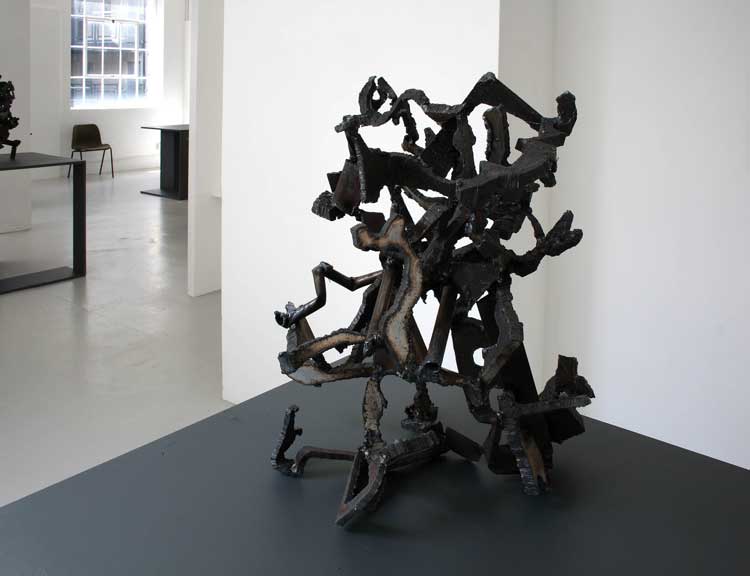
Robin Greenwood, S.3817, 2022. Steel, height approx 70 cm. Image courtesy of the artist.
The paintings and sculptures upstairs almost seem the work of two different artists, albeit each highly sympathetic to the other’s endeavour. Downstairs in the studio, despite the difficulties in seeing anything completely, there is a more obvious communality between Greenwood’s paintings and sculptures. A highly developed and immediately apparent clarity of detail is partly what separates the small sculptures upstairs from the paintings, whose terms, for all their numerous incidents, are broader, more general, more liable to disperse into turbulent, swirling fields of colour and matter. The collaged elements in some of the paintings seem intended to break through this generality, although for me, with the exception of Calcite: Cult, a lively narrow upright near the door, the paintings without collaged elements are the most convincing.
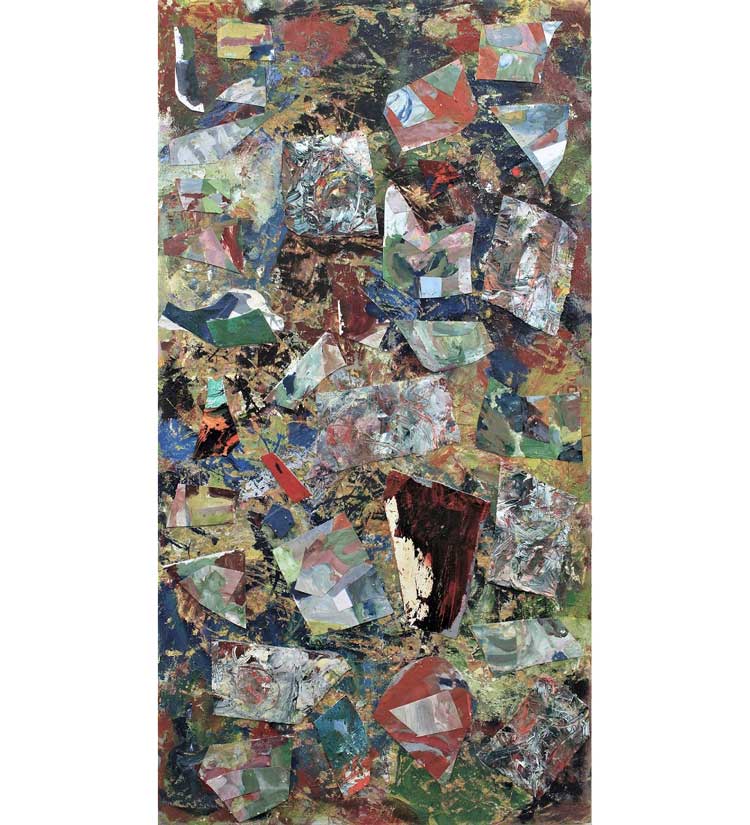
Robin Greenwood, Calcite Cult, 2020. Oil and collage, 114 x 60 cm. Image courtesy of the artist.
The level of controlled, concentrated complexity in the small sculptures is astonishing. They mix lightness and weight, solid craftsmanship and free exploration, certainty with restlessness and flexibility. That Cézanne is one of Greenwood’s heroes is apparent in his paintings and sculptures, but becomes a living reality in the handling of the small sculptures. Intricate parts move over and under each other, forming entwined lattices, sometimes dense and choppy, elsewhere looser, more open. A twisting sculpture with a bent length of pipe zigzagging through its core is especially dynamic.
For all the variety with which Greenwood approaches his steel in these small works, his true subject seems less the material itself and more the space that exists within and immediately around it. Space here is gripped tactility, more than it is divided up visually, aided by the roughly textured edges of the cut steel. Complex sets of spaces morph into each other. A space that is tightly defined from one angle is revealed from another viewpoint as part of a larger continuum, a process repeated as we move around the sculptures, producing sensations of compression and release, and never-ending movement. These sculptures seem to say – or better, to demonstrate – that space is something specific yet always changing; intense yet fugitive; unavoidably physical and always about to disappear into thin air.
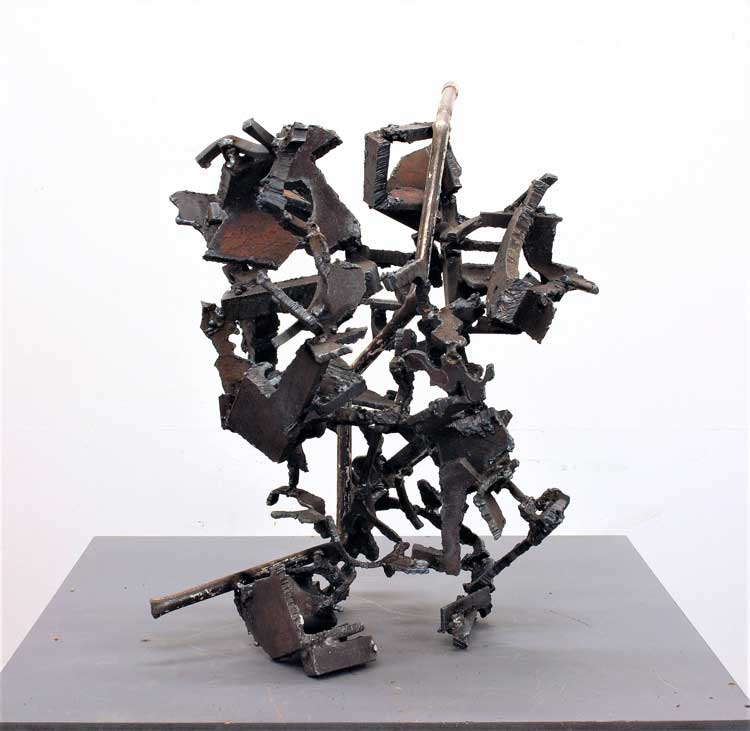
Robin Greenwood, S.3827, 2022. Steel, height approx 70 cm. Image courtesy of the artist.
If the smaller sculptures upstairs are primarily concerned with the manipulation of space, the larger works downstairs tend towards demonstrations of brute matter. Sheer materiality overwhelms the clarity of detail found in the smaller sculptures, as well as the specificity of individual spaces. This difference might lessen if the larger sculptures were more sympathetically displayed but I don’t think it would dissipate. Rather than leading us into the spaces they contain, their bulk expresses itself externally, as whole presences. Most of the smaller sculptures involve a pointed contrast between a main structure of heavily worked steel plate and elements of lighter, more obviously “found” piece of steel. In the larger works this expands into a wild material exuberance, with lines of steel looping around densely and highly detailed accumulations of steel plate, dotted with fragments of I-beam or bar. There is a much greater willingness to approach chaos or collapse, setting highly controlled passages, sometimes resembling decorative fretwork, against areas that suggest a disordered scrapheap brought to life. The effect is both joyful and disturbing.
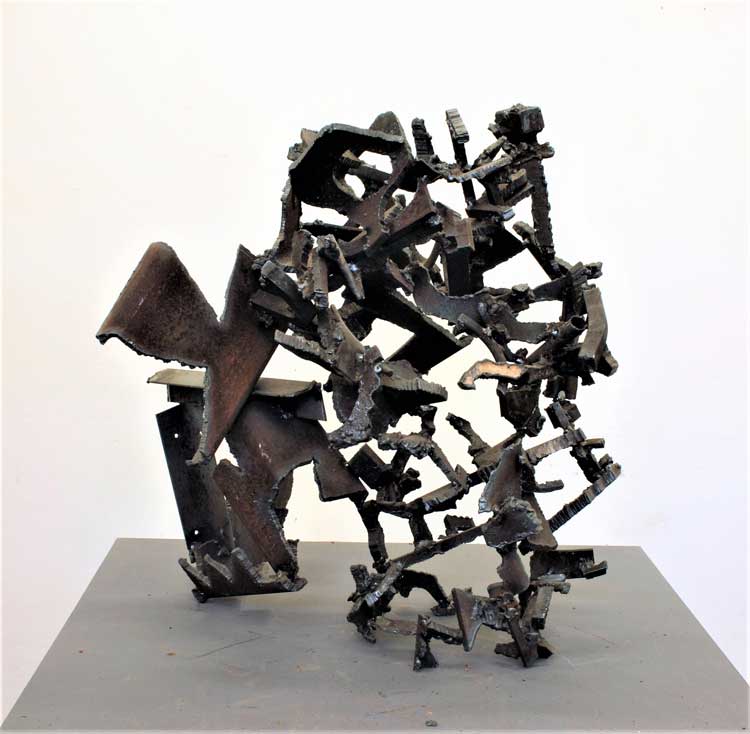
Robin Greenwood, S.3828, 2022. Steel, height approx 70 cm. Image courtesy of the artist.
These sculptures exist within a broad continuum of late modernist sculpture. We should mention his contemporaries Tim Scott, Katherine Gili, Anthony Smart and Mark Skilton. But a broader view, especially relevant with the larger sculptures shown here, might include the Lynch Fragments of Melvin Edwards, the “bird-nest” sculptures of John Panting, the later bronzes of William Tucker, the accumulations of John Chamberlain and Peter Buggenhout and the baroque extravagances of Frank Stella, even if Greenwood himself would reject most of these comparisons.
However much time we spend on our screens, we still have bodies and an existence inseparable from the physical world. These vital and personal examples of late modernism are powerful reminders of this fact. Will future developments in Greenwood’s art come from the spatial refinements of his smaller sculptures or the almost uncontrolled physicality of the larger ones?